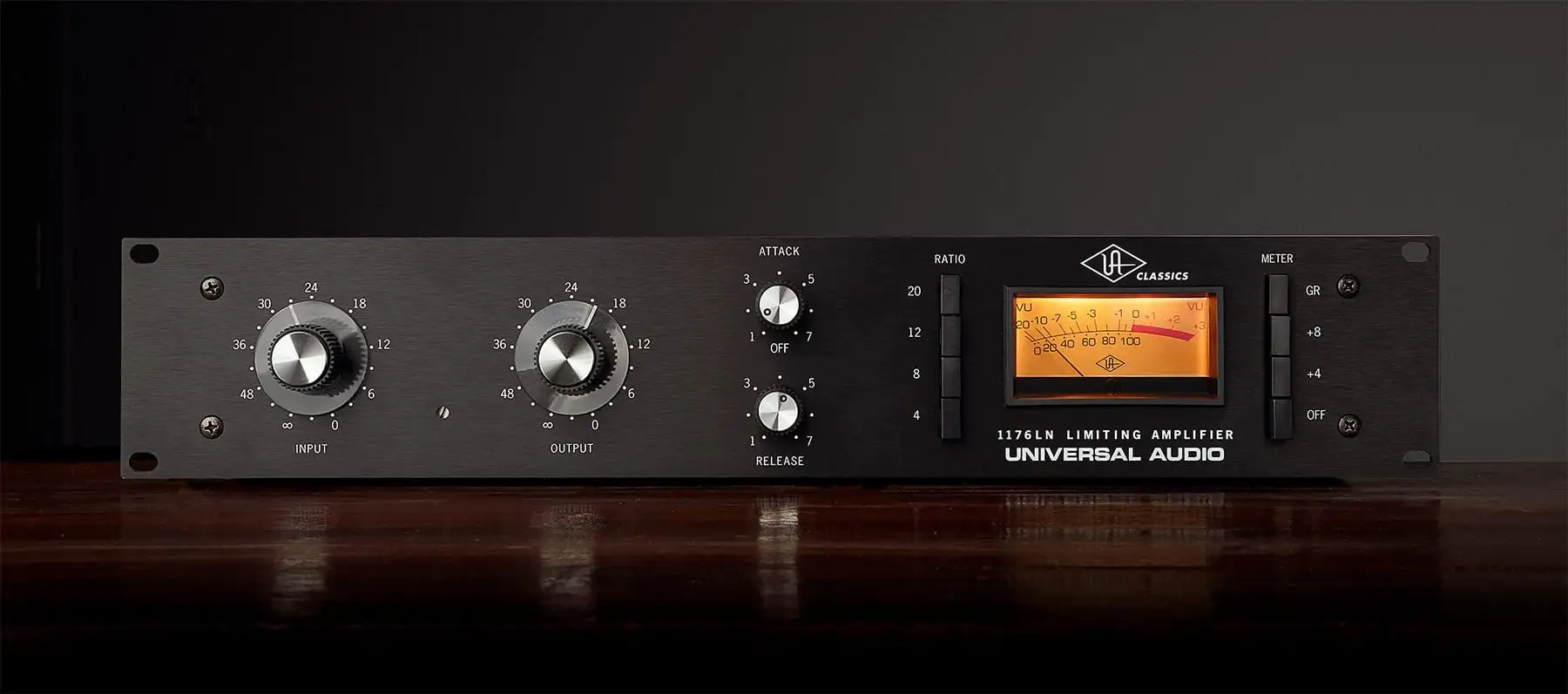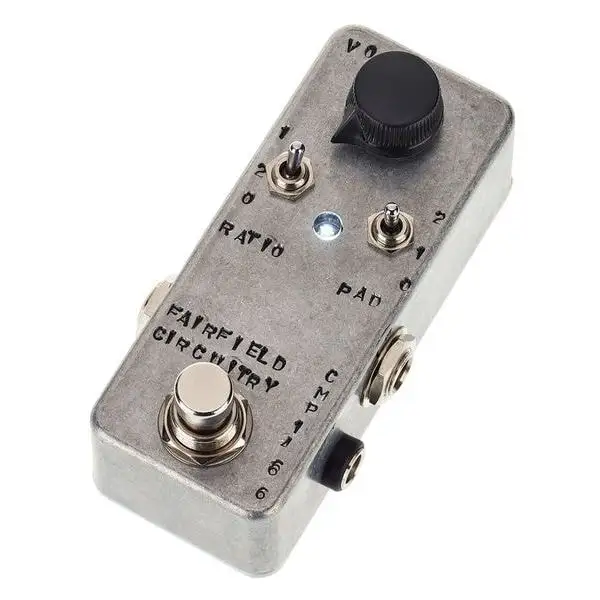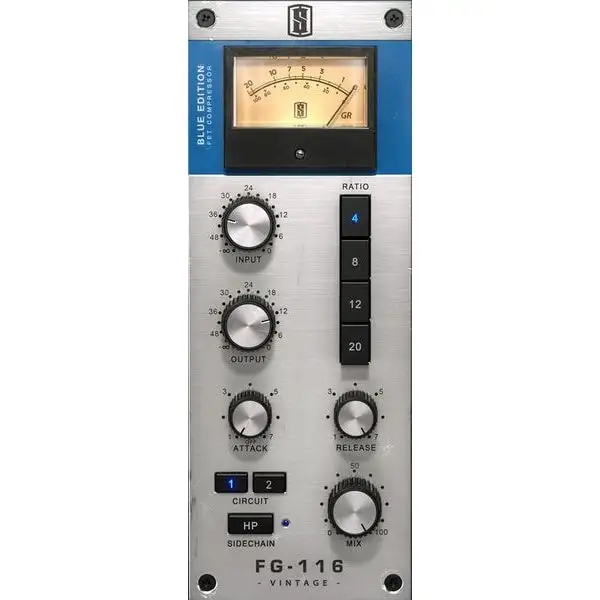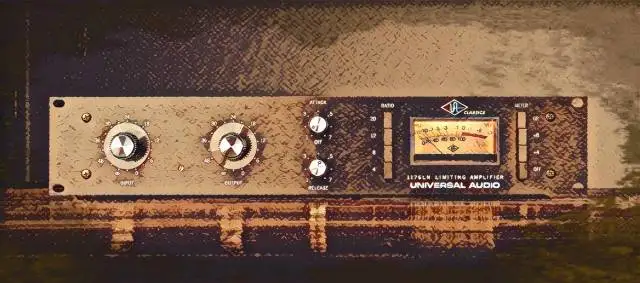If you like your mixes punchy, with a unique vintage harmonic distortion, then a good quality FET compressor is your best bet.
There are a couple of things that make FET compressors stand out. They have fast attack and release times that allow them to control transients in a unique way, creating a transparent compression that preserves the energy of your musical instrument, whichever it might be.
Today, we’ll dive into the world of FET compressors. We’ll analyze the technology behind them, how you can make the most of their features, and the best hardware/software to make your mixes shine.
What is a FET compressor?
FET stands for Field Effect Transistor. These types of transistors are responsible for the swift attack and release times FET compressors are known for, but also for their ability to achieve compression without sacrificing the natural sound or causing unwanted distortion. This makes them a great ally when you want to add vibrant dynamics to your music.
Recording studios started using FET compressors as transistors to replace big vacuum tubes in audio equipment. In 1968, the legendary 1176 Compressor was released, and its sound signature has been emulated countless times since then.
Unlike a voltage-controlled amplifier that uses electronic circuits to control gain, FET compressors use field effect transistors to create their unique sound signature and punchy sound.
One of the most interesting features of FET compressors is that their attack time is usually quicker than other audio compressor types; thanks to the FET technology it employs, this compressor has quite a snappy character when compared to a variable mu compressor or an optical compressor!
After the compression happens, the side chain signal is pulled from the gain reduction stage and is processed through a FET that works in its linear region. As a result of these innate qualities, this compressor is great at controlling the dynamics of powerful drums but also works magnificently with heavy guitar riffs, percussion, or powerful vocals.
All in all, if you want to add some energy and a timeless vibe to your mix, FET compressors are a great option, especially if you work with parallel processing a lot.
Settings of a FET Compressor
Let's take a look at the basic controls you can find in a FET compressor. These are the settings that you'll find in most compressors, be they software or hardware:
- Input: This knob controls how much signal is sent into the compressor; the more you push the input, the closer you get to the threshold, which is when the compression kicks in. With this type of compressor, when you drive it hard, you can really saturate the sound.
- Output: This control helps adjust how much level you send to your DAW or recording machine. If you hit the compressor hard, you'll use the output to dial back the level and avoid any clipping. If you're not hitting it hard enough, you can give it some extra makeup gain to the output signal with this control.
- Attack: This setting defines how fast the compressor responds once the signal crosses the threshold.
- Release: It controls how long the compression stays active after the signal goes over the threshold.
- Ratio: How much the signal is reduced once it goes over the threshold. For example, a 2:1 ratio means that if the signal exceeds the threshold by 2 dB, it will be brought down to just 1 dB above it.
Some FET compressors also come with a gain reduction meter; this is a great tool to control the audio signal as it allows you to visualize how much gain reduction you're applying to the input signal through the gain reduction circuit.
Best Uses for a FET Compressor
The "standard" setting for all FET compressors is to use the slowest attack and fastest release. This way, you keep the dynamics in your recording while mitigating the loud transients.
This makes FET compressors great for mixes that require a lot of energy: rock, hip hop, heavy metal, funk, EDM, and more. However, this is such a versatile audio compressor that it’s been used in countless records across genres.
There's no doubt FET compressors are great with powerful transients, but that doesn't mean they can't create subtle effects too, especially when applying parallel compression.
Let’s take a look at how a FET compressor can affect each instrument in the mix. Bear in mind that the next section is based on my personal experience, but there are countless other ways to use high-quality audio compression to improve your mixes, so make sure you explore the full potential of your compressor.
Drums
FET compressors are a fantastic option for drums in general, but especially with kick drums and room microphones.
They respond quickly, meaning they can really enhance the punch of a hit while keeping the sound solid and cohesive. When you apply them to room mics, they help capture the natural sound and vibe of the drum kit.
All in all, this compression tightens up the drums and makes the sound louder and more focused, without over-compressing it.
Vocal Tracks
When it comes to vocals, a lot can be done with an FET compressor. Personally, I like to use a moderate ratio setting, which tends to emphasize the subtle vocal details while keeping the dynamic range in check.
An FET compression can also add warmth to vocal tracks and manage sibilance and peaks, all without introducing non-linear compression or losing the natural flow of a vocal performance.
This is a compressor that celebrates authenticity: it lets the vocals shine through clearly, leaving the voice's tonal characteristics untouched.
Bass Guitar
I assure you that, when you use FET compression on a bass guitar, you achieve a punchy and consistent low-end sound that always works. This compressor has a way of managing the low-frequency dynamics so that they won't overwhelm other instruments, which is all I need from a first-class compressor when mixing bass guitars.
Electric Guitars
When it comes to electric guitars, FET compressors add punch, warmth and a slight overdrive to the tone. They also tend to smooth out long notes and make them more present.
Plus, they preserve the sharp attack of each note, which helps you keep the sound lively but also under control.
When using FET compressors on guitars and bass, input gain and output gain settings are critical; adjusting these parameters will give you total control over the gain stage and overall signal level.
How to Apply FET Compression to Your Mix
As I mentioned earlier, FET compression works wonders on instruments that need a little extra punch; drums and electric guitars come to mind, but if you’re working on a rock song with aggressive vocals, this compressor can truly make a singer's voice shine.
Here are a few suggestions if you’ve just started exploring FET compressors.
- Start with a fast attack . That's a great way to tame sharp transients, plus it will make your sound more defined and engaging.
- Set a quick release . It'll keep the energy up but also make the compression feel more natural.
- A ratio of about 4:1 is always a safe option, but if you're looking for something a bit more aggressive, don't be afraid to test its limit. A compressor often excels when pushed hard!
- When it comes to the threshold , I always apply 3 to 6 dB of gain reduction. Between these levels you can always find a sweet spot to keep the natural dynamics intact while giving your mix more punch.
- With the gain , it’s important to make sure your output level matches the original signal when you bypass the compressor, keeping everything balanced and sounding great.
If you're feeling adventurous, there are a few extra things you can try to make the most of FET compression.
You might want to try parallel compression. Mixing the compressed signal with the dry signal is the best way to preserve natural transients while still adding some nice punch.
Also experimenting with slower attack times and different ratio controls can help you get a more natural compression effect; furthermore, mixing the feedback signal and external side chain signal is also a great way to energize your mix.
All FET compressors are different, so take your time to understand yours and experiment with all its settings until you find the perfect balance.
Most Popular FET Compressors
Hardware FET Compressors
Universal Audio 1176LN

It's hard not to find the legendary Universal Audio 1176LN in a professional recording studio! Since it first came out in 1967, this FET compressor has become the standard compressor for a plethora of genres, ranging from hard rock to hip-hop, providing everything from subtle compression to colored distortion.
Its Class A output stage and custom transformers enhance the sonic character of any signal, and the selectable compression ratios and unique "Nuke Mode" offer endless creative sound solutions. It's expensive, but it's also the best FET compressor out there.
Purple Audio MC77
The Purple Audio MC77 is the new version of a classic compressor that comes with cutting-edge circuitry and balanced connections. It reacts quickly and has plenty of great features, like sidechain input and the ability to link in stereo.
It works magnificently with vocals, bass, and drums, and it has the innate ability to add clarity to a mix. It's essentially a "clone" of the 1176, but it costs less, while still offering a lot in terms of versatility and authenticity.
Warm Audio WA76-A2
The Warm Audio WA76-A2 is a dual-channel compressor that exudes the vintage analog vibe of the iconic Blue Stripe '76. With a cutting-edge signal path and modern features like selectable input impedance and variable sidechain filtering, this is a Swiss army knife of a compressor you can't go wrong with.
A versatile tonal character, fast dynamic control, and a timeless vintage feel make it a great option for any instrument or style.
Black Lion Audio Bluey
Inspired by Chris Lord-Alge's own 1176 limiter, the Black Lion Audio Bluey comes with Class A circuitry, a vintage-like PCB layout, a Wet/Dry mix, and stereo linking. It's a phenomenal compressor for vocals, but it can do wonders with any musical instrument. For less than $1000, it's hard to find anything better than this.
Pedal FET Compressors
Fairfield Accountant

The Fairfield Circuitry Accountant is a versatile and reasonably-priced JFET feedback compressor that you can use on anything, from single instruments to entire mixes.
The straightforward control interface allows adjustments to the threshold, compression ratio, and makeup gain. Light compression adds consistency with subtle coloration, whereas heavy compression adds richness and plenty of volume. It also comes with a limiter functionality and an input pad option.
JHS Whitey Tighty
The JHS Whitey Tighty comes with a 3-knob setup you can use to easily adjust Volume, Compression, and Blend (which allows you to mix the unaffected tone with the compressed signal) to achieve everything from subtle smoothing to powerful compression.
Built to last with true-bypass switching, the JHS Whitey Tighty is as intuitive as it can be, and can shape the transients in ways I never thought possible. For the price, it's unbeatable.
Cali76 FET Compressor
The Cali76 FET features all-analog circuitry and comes with all the controls you'll ever need: ratio, attack, release, and dry blend. It's designed specifically for electric guitars with ultra-high impedance jacks, and with dry blend control for parallel compression, you can manage dynamics, achieve long sustain, and explore endless tones.
Compared to the other pedals in this list, we're on the expensive side, but if you're a guitarist, the Cali76 FET is a fantastic compressor you have to try.
Software FET Compressors
If you decide to go for FET compressor plugins, there are certain features you should definitely look for: gain control, detector circuit customization, and program-dependent settings. After all, you want to make the most of what modern technology allows, right?
That said, here are what I think are the best plugins that recreate a genuine FET compression effect.
Universal Audio 1176 Collection
As you might expect, this is an exceptional plugin collection. It comes with three iconic 1176 models, Rev A, Rev E, and Rev AE, but it also adds modern features like a Sidechain Filter and Dry/Wet mix control.
Whether you're a seasoned engineer or a beginner, the Universal Audio 1176 Collection is a timeless studio essential.
Waves CLA-76
The Waves CLA-76 is a homage to the iconic 60s limiting amplifier of the same name. Its All Control feature replicates the analog performance by activating all ratio buttons simultaneously, and its modeled pre-amp distortion delivers an edge that can elevate any instrument.
Slate Digital FG-116

The Slate Digital FG-116 is a versatile FET compressor plugin that combines the character of vintage limiters with modern commodities. It comes with a Mix control for parallel compression and a Sidechain option with a highpass filter, and it's one of the best FET compressors you can get below $200.
IK Multimedia Black 76
If you're on a budget, the Black 76 is a versatile compressor and limiter plugin with a characteristic sonic signature, a user-friendly interface, and useful features like ultra-fast attack and "all buttons in" mode. It's a great option for beginners, but powerful enough to be used by professionals.
Final Thoughts
FET compressors are formidable, versatile, and unique in the way they can shape your mix. It might not be the most intuitive type of compressor out there, but once mastered, it can enhance the power of a track unlike any other tool.
If this is the first time you use a FET compressor, I suggest you follow my recommendations to start shaping your sound, and gradually make adjustments to the settings to create a mix that’s truly yours. With a high-quality FET compressor, options to improve your sound are truly endless.
Happy mixing!





